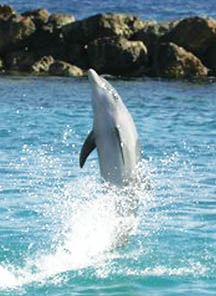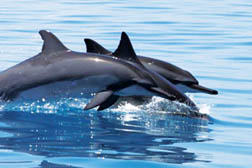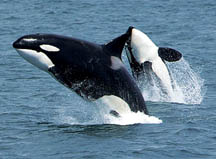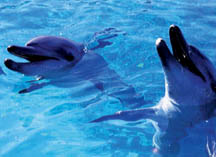|
observer |
|
|
|
|
|
OTHER LINKS |

|

|

|
|
|
|
|
It is thick and has less glands. The skin is sloughed (shed) off and replaced constantly in order to keep it smooth. It is this smoothness of skin that helps reduce heat loss and also enables the dolphins to travel at high speeds.
However, the disadvantage is that the skin is easily scarred and damaged. They have streamlined bodies with pectoral flippers and tail flukes. The skin is grey coloured with a lighter underside and a dark cape on the back.
The ears are hardly noticeable because they are marked only by a small hole, located just behind the eyes. In the species known as Bottlenose, the ears are about 5-6 cm behind the eyes and around 2-3 mm in diameter. Their hearing is superior to that of humans.
|
|
Their eyes are protected from water friction and foreign objects by a special secretion which is slippery. They have acute eyesight both in and out of water. Most species of dolphins have elongated jaws which form a distinct beak. In Bottlenoses, this curved mouth looks more like a fixed smile.
Their sense of touch is well developed, but as they have no ol- factory nerves, they have no sense of smell. They have loads of teeth, in some species they can be as much as 250! The teeth are set in interlocking rows. They have large brains and some attribute it to their intelligence.
Habitat, species and distribution
Dolphins are found worldwide, mostly in the shallow seas of continental shelves. Of the 38 odd species identified, four main species are found in the waters around Hawaii. They are the Pacific Bottlenose Dolphin, Rough-toothed Dolphin, Spotted Dolphin and Spinner Dolphin.
Endangered
Most species are under threat, with some such as the Pink Dolphin, Black Dolphin, Amazon River Dolphin and the Yangtzi River Dolphin in the critically endangered list. About 17 species are known to exist in the Yangtzi river alone. In Chile, one of the most endangered species, the Black Dolphin is hunted to provide bait for crab pots for the crab industry. Japan is known to be the largest consumer of dolphins. They are a protected species in the US.
Locomotion and communication
The dolphins are high speed swimmers and they use their tails and flippers to get about. While the tail flukes are used to move in and up/down motion, hunt and also hit out at a fleeing fish, the pectoral flippers are used to steer and stroke each other. They can dive to great depths and leap to great heights. When they encounter a predator, most often they get away by leaping or diving.
|
|
They communicate by making a variety of clicking sounds, whistling and other vocalisation. In fact, research carried out by marine scientists has revealed that dolphin mums of certain species whistle to their babies constantly so that the babies which are called calves can identify them. Most are known to have their own signature tunes by which they can be identified, like the names we humans have as an identification.
How dolphins echolocate and communicate
* Dolphins generate ultrasonic clicks in the nasal passages beneath the blowhole. These sound waves are focused into a narrow beam in a dome-shaped, cavity which is filled with fat and is known as the melon. The beam is then directed at potential targets and the returning echo reaches the inner ear of the dolphin through an acoustic channel in its lower jaw. This too is filled with fat.
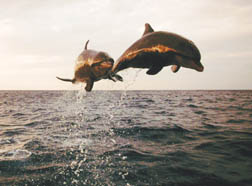
* In water, it is believed that the ultrasonic clicks of the spinner dolphin travel faster than they do in the air, and pass into the bodies of fish.
* When swimming together as a school, the dolphins make a number of sounds which includes clicks, whistles, barks and groans.
* Even though dolphins have their individual whistles, they may modify their unique whistle if there are clear benefits for other members of the school.
* Whistles and squakes vary between dolphins and appear to serve as individual specific identification messages, whereas some clicks may convey an individual's mood or emotional state.
More on dolphins next week.
***
Fact file
* Dolphins have a 20-40 year lifespan.
* The 38-40 known species includes the Killer Whale or Orcawhich may grow up to 30 feet in length. The smallest dolphin variety - Maui's Dolphin is around four feet long.
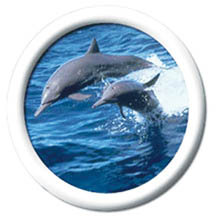
* Spinner Dolphins are found in the Atlantic - Indian and Pacific Oceans. They have long, slender beaks with a black tip and lip and also an erect dorsal fin.
* Dolphins come up for air every two minutes, but they can hold their breath upto five or eight minutes.
* They shed their outer skin every two hours.
* Dolphins are famous as rescuers of stranded whales other dolphins and even humans. They are also considered as aquatic healers.
* Dolphins take cat-naps, floating below the surface. At such times, only half of its brain shuts down and breathing is done under voluntary control.
* The Bottlenose Dolphin is the largest of the beaked dolphins and is known as the Tonina in the coasts of Mexico.

